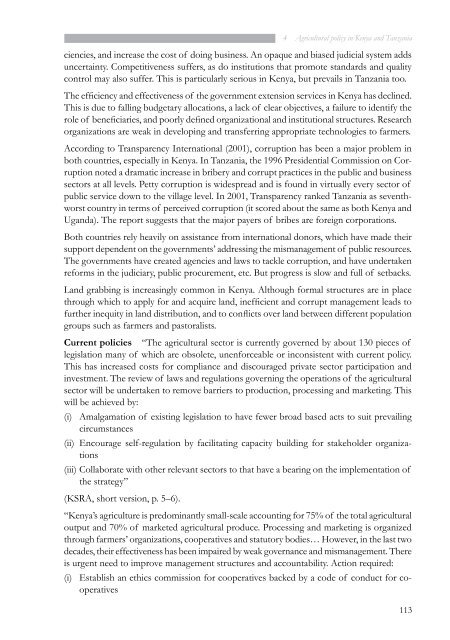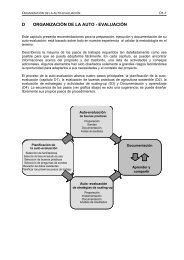cases from tanzania - Sustainet
cases from tanzania - Sustainet
cases from tanzania - Sustainet
You also want an ePaper? Increase the reach of your titles
YUMPU automatically turns print PDFs into web optimized ePapers that Google loves.
4 Agricultural policy in Kenya and Tanzania<br />
ciencies, and increase the cost of doing business. An opaque and biased judicial system adds<br />
uncertainty. Competitiveness suffers, as do institutions that promote standards and quality<br />
control may also suffer. This is particularly serious in Kenya, but prevails in Tanzania too.<br />
The efficiency and effectiveness of the government extension services in Kenya has declined.<br />
This is due to falling budgetary allocations, a lack of clear objectives, a failure to identify the<br />
role of beneficiaries, and poorly defined organizational and institutional structures. Research<br />
organizations are weak in developing and transferring appropriate technologies to farmers.<br />
According to Transparency International (2001), corruption has been a major problem in<br />
both countries, especially in Kenya. In Tanzania, the 1996 Presidential Commission on Corruption<br />
noted a dramatic increase in bribery and corrupt practices in the public and business<br />
sectors at all levels. Petty corruption is widespread and is found in virtually every sector of<br />
public service down to the village level. In 2001, Transparency ranked Tanzania as seventhworst<br />
country in terms of perceived corruption (it scored about the same as both Kenya and<br />
Uganda). The report suggests that the major payers of bribes are foreign corporations.<br />
Both countries rely heavily on assistance <strong>from</strong> international donors, which have made their<br />
support dependent on the governments’ addressing the mismanagement of public resources.<br />
The governments have created agencies and laws to tackle corruption, and have undertaken<br />
reforms in the judiciary, public procurement, etc. But progress is slow and full of setbacks.<br />
Land grabbing is increasingly common in Kenya. Although formal structures are in place<br />
through which to apply for and acquire land, inefficient and corrupt management leads to<br />
further inequity in land distribution, and to conflicts over land between different population<br />
groups such as farmers and pastoralists.<br />
Current policies “The agricultural sector is currently governed by about 130 pieces of<br />
legislation many of which are obsolete, unenforceable or inconsistent with current policy.<br />
This has increased costs for compliance and discouraged private sector participation and<br />
investment. The review of laws and regulations governing the operations of the agricultural<br />
sector will be undertaken to remove barriers to production, processing and marketing. This<br />
will be achieved by:<br />
(i) Amalgamation of existing legislation to have fewer broad based acts to suit prevailing<br />
circumstances<br />
(ii) Encourage self-regulation by facilitating capacity building for stakeholder organizations<br />
(iii) Collaborate with other relevant sectors to that have a bearing on the implementation of<br />
the strategy”<br />
(KSRA, short version, p. 5–6).<br />
“Kenya’s agriculture is predominantly small-scale accounting for 75% of the total agricultural<br />
output and 70% of marketed agricultural produce. Processing and marketing is organized<br />
through farmers’ organizations, cooperatives and statutory bodies… However, in the last two<br />
decades, their effectiveness has been impaired by weak governance and mismanagement. There<br />
is urgent need to improve management structures and accountability. Action required:<br />
(i) Establish an ethics commission for cooperatives backed by a code of conduct for cooperatives<br />
113




